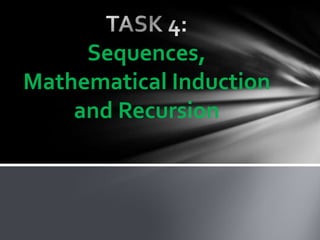
Task4 present
- 1. Sequences, Mathematical Induction and Recursion
- 2. SEQUENCES Definition : ordered set of mathematical objects.
- 3. EXAMPLE PROBLEM Find the sum of all the integers from 1 to 1000. The sequence of integers starting from 1 to 1000 is given by 1 , 2 , 3 , 4 , ... , 1000 The above sequence has 1000 terms. The first term is 1 and the last term is 1000 and the common difference is equal to 1. We have the formula that gives the sum of the first n terms of an arithmetic sequence knowing the first and last term of the sequence and the number of terms (see formula above). s1000 = 1000 (1 + 1000) / 2 = 500500
- 4. TYPE OF SEQUENCE Sequeance Special Arithmetic Geometric Integers Sequences Sequences Sequence
- 5. WHAT IS ARITHMETIC SEQUENCE In an Arithmetic Sequence the difference between one term and the next is a constant. In other words, you just add the same value each time ... infinitely.
- 6. In General you could write an arithmetic sequence like this: {a, a+d, a+2d, a+3d, ... } where: a is the first term, and d is the difference between the terms (called the "common difference")
- 7. Geometric Sequence In a Geometric Sequence each term is found by multiplying the previous term by a constant. In General you could write a Geometric Sequence like this: {a, ar, ar2, ar3, ... } where: a is the first term, and r is the factor between the terms (called the "common ratio")
- 8. SPECIAL INTEGER SEQUENCE Triangular • This Triangular Number Sequence is generated from a pattern of dots which form a triangle. Numbers Square • Square numbers, better known as perfect squares, are an integer which is the product of that integer with itself. Numbers Fibonacci • The Fibonacci Sequence is found by adding the two numbers before it together. Numbers • A cube number sequence is a mathematical sequence consisting of a Cube Numbers sequence in which the next term originates by multiplying the number 3 times with itself, or in other words, raising it to the power of three
- 9. Triangular Numbers An example of this type of number sequence could be the following: 1, 3, 6, 10, 15, 21, 28, 36, 45, … This sequence is generated from a pattern of dots which form a triangle. By adding another row of dots and counting all the dots we can find the next number of the sequence.
- 10. Continue….
- 11. Square Numbers 1, 4, 9, 16, 25, 36, 49, 64, 81, … The next number is made by squaring where it is in the pattern. The second number is 2 squared (22 or 2 2) The seventh number is 7 squared (7 2 or 7 7) etc
- 12. Fibonacci Numbers 0, 1, 1, 2, 3, 5, 8, 13, 21, 34, … The Fibonacci Sequence is found by adding the two numbers before it together. The 2 is found by adding the two numbers before it (1+1) The 21 is found by adding the two numbers before it (8+13) The next number in the sequence above would be 55 (21+34)
- 13. Cube Numbers 1, 8, 27, 64, 125, 216, 343, 512, 729, … The next number is made by cubing where it is in the pattern. The second number is 2 cubed (23 or 2 2 2) The seventh number is 7 cubed (7 3 or 7 7 7) etc
- 14. Give 1 example sequences use in computer programming Sequence in computer programming is the default control structure, instructions are executed one after another. They might, for example, carry out a series of arithmetic operations, assigning results to variables Example:- Make a list number of 100 students that attend “seminar keusahawanan”. Pseudocode BEGIN Declare a list as an array with 100 elements for (int student = 0, student<100; student++){ list[student] = student + 1 (arithmetic operation) print list[student] } END
- 15. Answer: No.Student = 0 Print list[student] = 1 No.Student = 1 Print list[student] = 2 . . . . Print list[student] = 99 No.Student = 100
- 16. Source Code public class sequences { public static void main(String[] args) { int list [] = new int[100]; for(int student = 0; student<100; student++) { list[student] = student + 1; System.out.println(list[student]); } } }
- 17. PRINCIPLE OF MATHEMATICAL INDUCTION & METHOD OF PROOF PRINCIPLE OF MATHEMATICAL INDUCTION To prove that P(n) is true for all positive integers n, where P(n) is a propositional funtion METHOD OF PROOF 1) BASIS STEP: We verify that P(1) is true. 2) INDUCTIVE STEP: We show that the conditional statement P(k) → P(k + 1) is true for all positive integers k.
- 18. Problem1: Show that if n is a positive integer, then 1 + 2 + ... + n = n(n + 1)/2. BASIC STEP: P(1), 1 = 1(1 + 1)/2 1 =1 (RHS=LHS) INDUCTIVE STEP: we assume that 1 + 2 + ... + k = k(k + 1)/2 it must be shown that P(k + 1) is true, 1 + 2 + ... + k + ( k +1) = (k + 1)[( k+ 1) (k +1) + 1] /2 = (k + 1)(k + 2)/ 2 Add k +1 to both sides of the equation P(k) 1 + 2 + ... + k + (k +1) = k(k +1) /2 + (k +1) = k(k +1 ) + 2 (k +1 )/2 = (k + 1) (k + 2)/2
